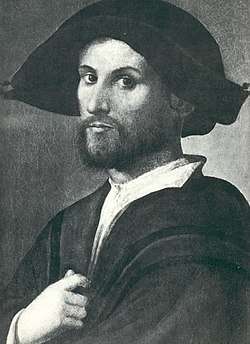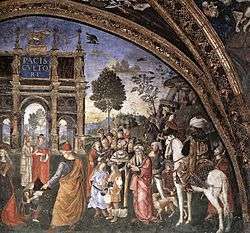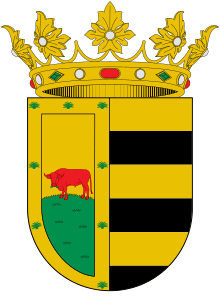Giovanni Borgia, 2nd Duke of Gandía
Giovanni Borgia, 2nd Duke of Gandía (1474 or 1476–1497) was the son of Pope Alexander VI and a member of the House of Borgia. He was murdered in 1497. He was the brother of Cesare, Gioffre, and Lucrezia Borgia. Giovanni, commonly known as Juan (or sometimes, Joan), is believed to be the eldest of the Pope's four children by Vannozza dei Cattanei,[2][3] but this is disputed. Due to the contents of a number of papal bulls issued after his murder, it is unclear whether Giovanni was born in 1474 or 1476.
Giovanni Borgia | |
|---|---|
| Duke of Gandía | |
 Alleged portrait of Giovanni Borgia | |
| Reign | 1488–1497 |
| Born | c. 1474[1] Italy |
| Died | 14 June 1497 Rome |
| Noble family | Borgia |
| Spouse(s) | Maria Enriquez de Luna |
| Issue
Juan de Borja y Enriquez, 3rd Duke of Gandia Francisca Jesus de Borja Isabel de Borja y Enriquez | |
| Father | Pope Alexander VI |
| Mother | Vannozza dei Cattanei |
| Religion | Roman Catholicism |
Early life, marriage, and family

Giovanni Borgia was probably born in Rome to then-cardinal Rodrigo Borgia (later to become Pope Alexander VI), and his mistress, Vannozza dei Cattanei, who was married to Domenico da Rignano. Giovanni married Maria Enriquez de Luna, the Spanish betrothed of his deceased older half-brother, Pedro Luis,[4] in September 1493. He was made 2nd Duke of Gandia, Duke of Sessa, Grand Constable of Naples, Governor of St. Peter's, and Gonfalonier and Captain General of the Church.
Giovanni and Maria had three children: twins Juan de Borja y Enríquez (known as Juan Borgia, father of Saint Francis Borgia), who became the 3rd Duke of Gandía, and Francisca de Jesús Borja, who became a nun at a convent in Valladolid. Their third child, Isabel de Borja y Enríquez, was born after her father was killed; she grew up to be abbess of Santa Clara in Gandia.
Murder

Borgia was murdered the night of 14 June 1497 near what later became the Piazza della Giudecca in the ghetto of Rome. Giovanni was last seen alive when he was leaving from a feast that his mother had in his honor at her villa with his other siblings Cesare, Lucrezia, and Gioffre; Gioffre's wife Sancha of Aragon, their cousin Juan Borgia Lanzol, and Vannozza's husband, Carlo Canale, were all in attendance. The next morning his horse came back without its rider and with one of the stirrups cut. He was reported missing. A search party found his body in the Tiber with his throat slit, and about nine stab wounds on his torso. His grief-stricken father launched an intensive investigation into the murder, only to end it abruptly a week later. While the Orsini family had ample motive to kill Giovanni, it was later rumored that his younger brother Gioffre Borgia murdered him due to Giovanni's relationship with Gioffre's wife, Sancha. His richly-attired body was recovered from the Tiber River with 30 golden ducats untouched in the purse at his belt. To the immense grief of the pope, this act occasioned the epigram by Sannazzaro on the pope as "fisher of men." Borgia's only attendant was also slain, so there were no known witnesses.[5]
In popular culture
In most adaptations, he is referred to by his Spanish name, Juan. In Alexandre Dumas' Celebrated Crimes (1839), he is referred to as Francesco.[6]
In Mario Puzo's historical novel The Family, Giovanni Borgia's murder by his younger brother Geoffre is central to the drama and plot of the story.
In the 2010 animated short film, Assassin's Creed: Ascendance, a fictionalised version of Juan's death is depicted at the hand of Cesare Borgia, who hires a prostitute to murder him.
In the 2011 Showtime series, The Borgias, Juan is played by David Oakes. This adaptation is younger than Cesare, and is killed by him in the second season of the series, in "World of Wonders". In the 2011 French/German series, Borgia, Juan is played by French actor Stanley Weber. He is a main character in the first season and dies in that season's finale "The Serpent Rises". In this adaptation, he is the eldest child of Rodrigo and Vannozza, and his murder is perpetrated primarily by Lucrezia—with the help of her lover, Pedro Caldes. Both portrayals depict Juan as haughty, selfish, and cruel, with few redeeming features.
The CBBC television show Horrible Histories features a song portraying the Borgia family, with Ben Willbond as Giovanni Borgia.
See also
- List of unsolved murders
- Route of the Borgias
Notes
- Maxwell-Stuart, P.G., Chronicle of the Popes, London, Thames and Hudson, 1997, page 158–159, ISBN 0-500-01798-0
- Christopher Hibbert: The Borgias and Their Enemies. Harcourt, Inc. 2008, p. 30
- Sarah Bradford: Cesare Borgia; His Life and Times. London, 1876, p. 17
- Williams, George L. (1998). Papal Genealogy: The Families and Descendants of the Popes. Jefferson, North Carolina: McFarland & Co. p. 217. ISBN 0-7864-2071-5.CS1 maint: ref=harv (link)
- Sabatini, II.4.
- Dumas, Alexandre (1839). Celebrated Crimes. Volume 1 (1910 English ed.). New York: P. F. Collier. p. 48. Retrieved 15 May 2017.
External links
- (in Spanish) Borja – Wikipedia, la enciclopedia libre
- (in Spanish) Borja o Borgia
- (in Spanish) Diario Borja – Borgia Tres siglos de Historia día a día